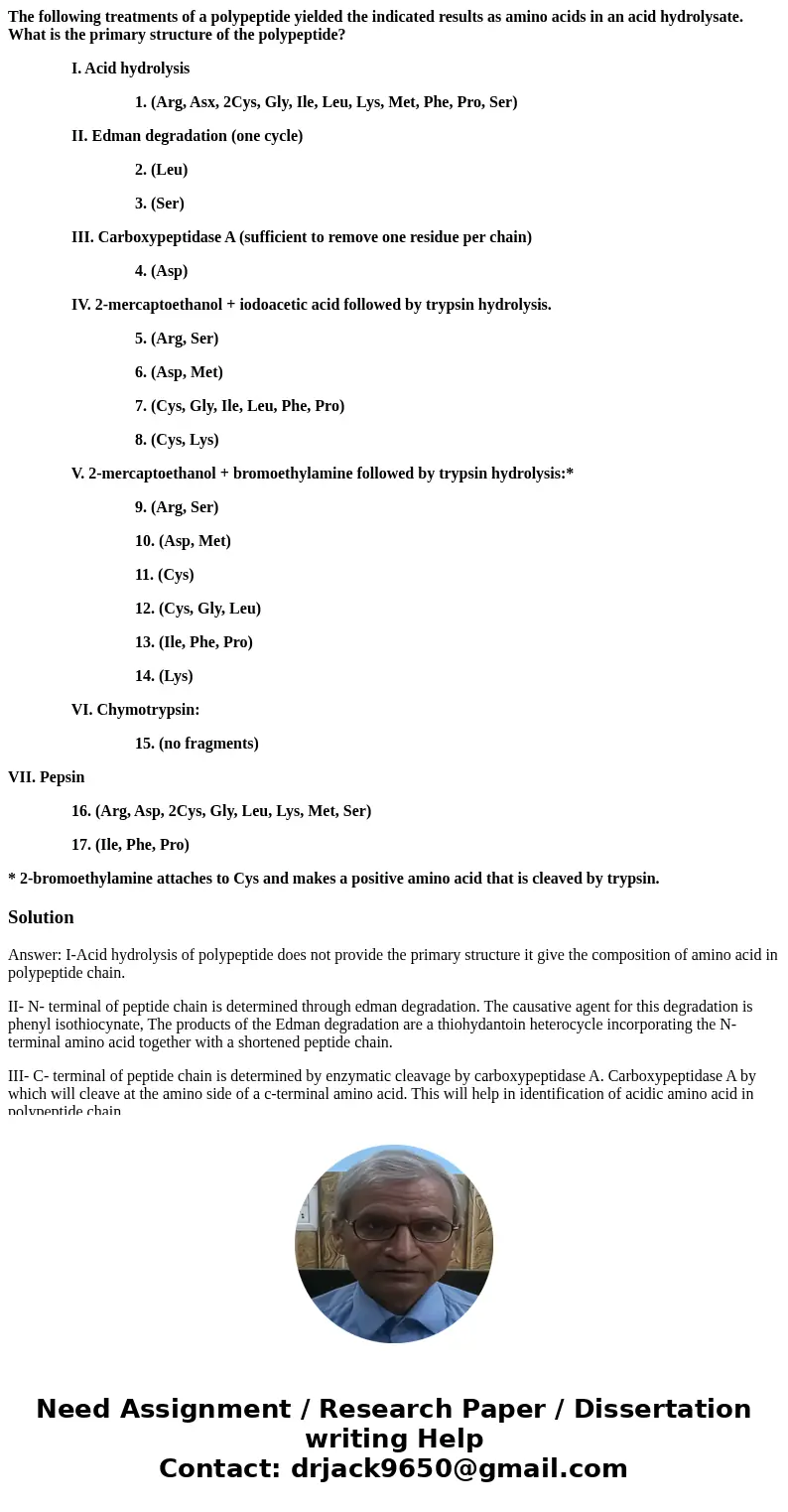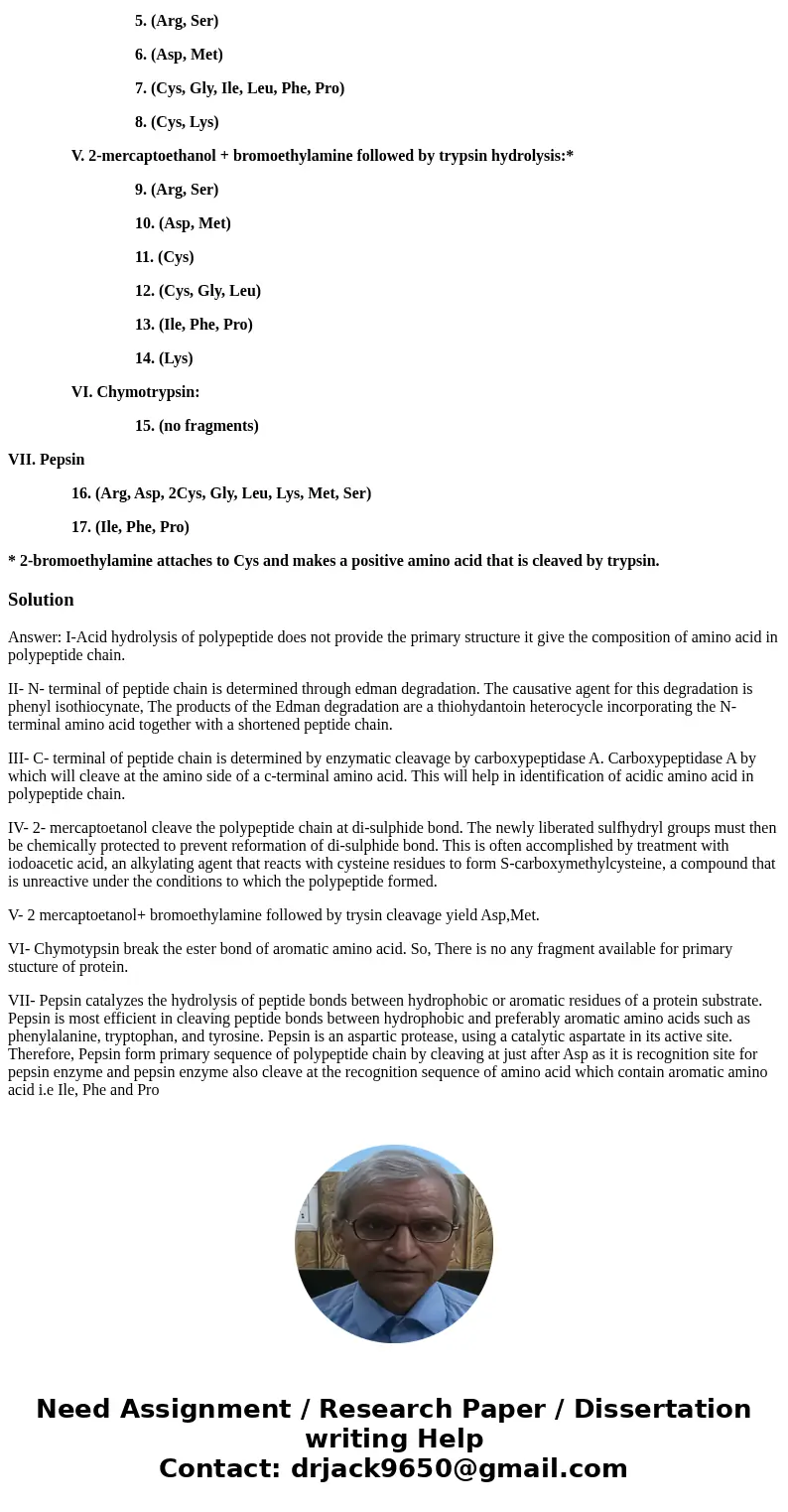The following treatments of a polypeptide yielded the indica
The following treatments of a polypeptide yielded the indicated results as amino acids in an acid hydrolysate. What is the primary structure of the polypeptide?
I. Acid hydrolysis
1. (Arg, Asx, 2Cys, Gly, Ile, Leu, Lys, Met, Phe, Pro, Ser)
II. Edman degradation (one cycle)
2. (Leu)
3. (Ser)
III. Carboxypeptidase A (sufficient to remove one residue per chain)
4. (Asp)
IV. 2-mercaptoethanol + iodoacetic acid followed by trypsin hydrolysis.
5. (Arg, Ser)
6. (Asp, Met)
7. (Cys, Gly, Ile, Leu, Phe, Pro)
8. (Cys, Lys)
V. 2-mercaptoethanol + bromoethylamine followed by trypsin hydrolysis:*
9. (Arg, Ser)
10. (Asp, Met)
11. (Cys)
12. (Cys, Gly, Leu)
13. (Ile, Phe, Pro)
14. (Lys)
VI. Chymotrypsin:
15. (no fragments)
VII. Pepsin
16. (Arg, Asp, 2Cys, Gly, Leu, Lys, Met, Ser)
17. (Ile, Phe, Pro)
* 2-bromoethylamine attaches to Cys and makes a positive amino acid that is cleaved by trypsin.
Solution
Answer: I-Acid hydrolysis of polypeptide does not provide the primary structure it give the composition of amino acid in polypeptide chain.
II- N- terminal of peptide chain is determined through edman degradation. The causative agent for this degradation is phenyl isothiocynate, The products of the Edman degradation are a thiohydantoin heterocycle incorporating the N-terminal amino acid together with a shortened peptide chain.
III- C- terminal of peptide chain is determined by enzymatic cleavage by carboxypeptidase A. Carboxypeptidase A by which will cleave at the amino side of a c-terminal amino acid. This will help in identification of acidic amino acid in polypeptide chain.
IV- 2- mercaptoetanol cleave the polypeptide chain at di-sulphide bond. The newly liberated sulfhydryl groups must then be chemically protected to prevent reformation of di-sulphide bond. This is often accomplished by treatment with iodoacetic acid, an alkylating agent that reacts with cysteine residues to form S-carboxymethylcysteine, a compound that is unreactive under the conditions to which the polypeptide formed.
V- 2 mercaptoetanol+ bromoethylamine followed by trysin cleavage yield Asp,Met.
VI- Chymotypsin break the ester bond of aromatic amino acid. So, There is no any fragment available for primary stucture of protein.
VII- Pepsin catalyzes the hydrolysis of peptide bonds between hydrophobic or aromatic residues of a protein substrate. Pepsin is most efficient in cleaving peptide bonds between hydrophobic and preferably aromatic amino acids such as phenylalanine, tryptophan, and tyrosine. Pepsin is an aspartic protease, using a catalytic aspartate in its active site. Therefore, Pepsin form primary sequence of polypeptide chain by cleaving at just after Asp as it is recognition site for pepsin enzyme and pepsin enzyme also cleave at the recognition sequence of amino acid which contain aromatic amino acid i.e Ile, Phe and Pro


 Homework Sourse
Homework Sourse